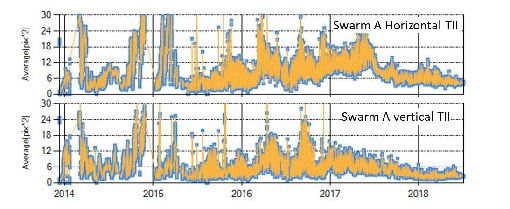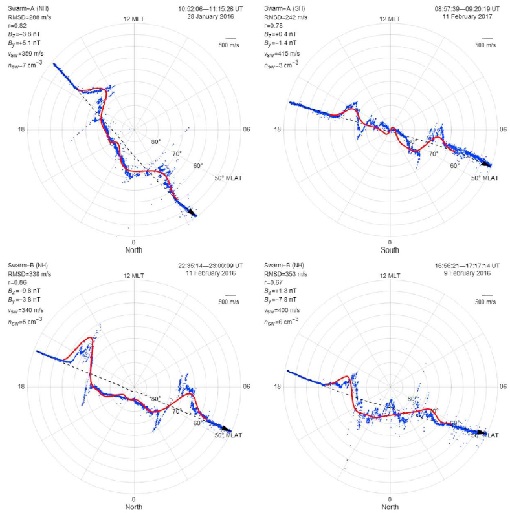- News & Events
- Significant improvements on Sw...
Significant improvements on Swarm Thermal Ion Imagers data
07 May 2019
The two Thermal Ion Imagers (TII) sensors on-board each Swarm spacecraft provide images of low-energy ion distribution functions in the horizontal and vertical planes, from which are obtained in-situ measurements of the ion drift velocity and the electric field component perpendicular to the magnetic field (Knudsen et al 2017).
Since the commissioning phase, TII measurements were affected by a transient image anomaly related to the presence of contaminants within the sensors (most probably water vapour, which was not seen prior to launch despite extended periods of detector testing), which prevent the continuous acquisition from TII sensors. These contaminants led to the appearance of a secondary signal to the main ion population that caused a significant increase of the values of second moment of the ion distribution functions measured by TII.
The constant improvement in the strategies to operate TII instruments, defined by scientists and engineers in dedicated monthly TII anomaly review board meetings (73 meetings to date), allow a significant increase in TII data coverage, and a substantial improvement in TII data quality.
In particular, the current procedure consisting in the alternation of acquisition and rests TII orbits, make it possible to significantly increase the TII data coverage - which was only 7% in May 2015 (one orbit per day of acquisition) - to more than 40% on average at present (eight orbits per day for Swarm Alpha and Bravo, and two orbits per day for Swarm Charlie). The ultimate aim is to restore the continuous 24/7 acquisition with TII instruments.
The improved operations on TIIs resulted in better control of TII anomalies that caused a continuous decrease of second moment of the ion distribution function, as shown in the image here below for the TII sensor on-board Swarm A.

measured by the two TII sensors onboard Swarm Alpa, since the beginning of mission to September 2018. Copyright: Courtesy of Johnathan Burchill
The ion drift velocities measured by Swarm A and B in high latitude ionosphere (almost two years of data), obtained with the more recent calibration, have been recently compared to the Weimer 2005 empirical convection electric field model (Lomidze et al., 2019).
The good statistical agreement of Swarm data with model predictions demonstrates that Swarm TII data, once corrected for variations in background levels, are not affected by systematic errors, they are able to correctly capture several well-known features of high latitude ionosphere showing more small-scale details with respect to the empirical model, and can be successfully applied to geophysical studies of the high latitude ionosphere (see the figure below).

Drift Velocities in the High-Latitude Ionosphere. Copyright: Courtesy of Wiley: Earth and Space Science, Volume: 6, Issue: 3, Pages: 411-432, First published: 1 March 2019, DOI: (10.1029/2018EA000546).
In fact, a number of geophysical studies analysed the Swarm ion drifts data to study the high-latitude ionosphere (Archer et al 2015; Fiori et al 2016; Juusola et al 2016; Archer et al 2017; Pakhotin et al 2018).
References:
- Archer, W. E.,D. J. Knudsen, J. K. Burchill, M. R. Patrick, and J. P. St.-Maurice (2015), Anisotropic core ion temperatures associated with strong zonal flows and upflows, Geophys. Res. Lett., 42, 981–986, doi:10.1002/2014GL062695
- Archer, W. E., D. J. Knudsen, J. K. Burchill, B. Jackel, E. Donovan, M. Connors, and L. Juusola (2017), Birkeland current boundary flows, J. Geophys. Res. Space Physics, 122, 4617–4627, doi:10.1002/2016JA023789
- Knudsen, D. J., J. K. Burchill, S. C. Buchert, A. I. Eriksson, R. Gill, J.-E. Wahlund, L. Åhlen, M. Smith, and B. Moffat (2017), Thermal ion imagers and Langmuir probes in the Swarm electric field instruments, J. Geophys. Res. Space Physics, 122, doi:10.1002/2016JA022571
- Fiori, R. A. D., A. V. Koustov, D. H. Boteler, D. J. Knudsen and J. K. Burchill (2016), Calibration and assessment of Swarm ion drift measurements using a comparison with a statistical convection model, Earth, Planets and Space (2016) 68:100 doi: 10.1186/s40623-016-0472-7
- Juusola, L., W. E. Archer, K. Kauristie, J. K. Burchill, H. Vanhamäki, and A. T. Aikio (2016), Ionospheric conductances and currents of a morning sector auroral arc from Swarm-A electric and magnetic field measurements, Geophys. Res. Lett., 43, 11,519–11,527, doi:10.1002/2016GL070248
- Lomidze, L., Burchill, J. K., Knudsen, D. J., Kouznetsov, A., & Weimer, D. R. (2019). Validity study of the Swarm horizontal cross‐track ion drift velocities in the high-latitude ionosphere. Earth and Space Science, 6, 411–432. doi: 2018EA000546
- Pakhotin, I. P., Mann, I. R., Lysak, R. L., Knudsen, D. J., Gjerloev, J. W., Rae, I. J.,… Balasis, G. (2018). Diagnosing the role of Alfvén waves in magnetosphere-ionosphere coupling: Swarm observations of large amplitude nonstationary magnetic perturbations during an interval of northward IMF. Journal of Geophysical Research: Space Physics, 123, 326–340. doi: 10.1002/2017JA024713